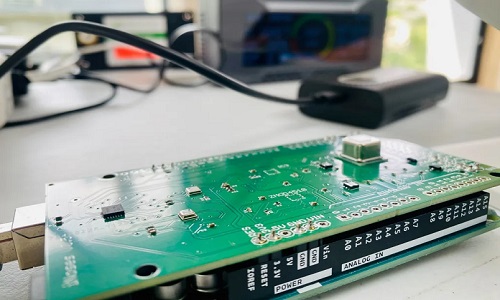
Welcome to the October 16, 2024 edition of ACM TechNews, providing timely information for computer professionals three times a week.
|
|
|
China has been increasingly assertive in the technology standard-setting process. Last month for example, the International Telecommunication Union approved three new technical standards that will be embedded in sixth-generation (6G) mobile technology, all developed by the Chinese Academy of Sciences and China Telecom. Unlike the West, which has tended to defer to private companies and industry associations in the standard-setting process, China’s approach is led by its government.
[
» Read full article
*May Require Paid Registration
]
The Economist (October 10, 2024)
|
 AI pioneer and ACM A.M. Turing Award laureate Yann LeCun says some experts are exaggerating AI's power and risks. LeCun believes today’s AI models lack the intelligence of pets. When an OpenAI researcher stressed the need to control ultra-intelligent AI, LeCun responded, “It seems to me that before ‘urgently figuring out how to control AI systems much smarter than us’ we need to have the beginning of a hint of a design for a system smarter than a house cat."
AI pioneer and ACM A.M. Turing Award laureate Yann LeCun says some experts are exaggerating AI's power and risks. LeCun believes today’s AI models lack the intelligence of pets. When an OpenAI researcher stressed the need to control ultra-intelligent AI, LeCun responded, “It seems to me that before ‘urgently figuring out how to control AI systems much smarter than us’ we need to have the beginning of a hint of a design for a system smarter than a house cat."
[
» Read full article
*May Require Paid Registration
]
The Wall Street Journal; Christopher Mims (October 11, 2024)
|
 Russia, China, and Iran rely on criminal networks to lead their cyberespionage and hacking operations against the U.S. and its allies, according to a report from Microsoft. In one example, investigators identified a Russian criminal network that infiltrated more than 50 electronic devices used by the Ukrainian military in June, apparently seeking access and information that could aid Russia’s invasion of Ukraine. Russia, China, and Iran rely on criminal networks to lead their cyberespionage and hacking operations against the U.S. and its allies, according to a report from Microsoft. In one example, investigators identified a Russian criminal network that infiltrated more than 50 electronic devices used by the Ukrainian military in June, apparently seeking access and information that could aid Russia’s invasion of Ukraine.
[
» Read full article
]
Associated Press; David Klepper (October 15, 2024)
|
 Lillian Schwartz, one of the first artists to use a computer to make films, died on Saturday at 97. Recipient of the ACM SIGGRAPH 2015 Distinguished Artist Award for Lifetime Achievement in Digital Art, Schwartz made her first film by feeding punch cards into an IBM 7094 mainframe computer to produce 85 black-and-white frames on magnetic tape. She later won a New York Emmy Award for a computer-generated public service announcement created for the opening of the renovated Museum of Modern Art in 1984.
Lillian Schwartz, one of the first artists to use a computer to make films, died on Saturday at 97. Recipient of the ACM SIGGRAPH 2015 Distinguished Artist Award for Lifetime Achievement in Digital Art, Schwartz made her first film by feeding punch cards into an IBM 7094 mainframe computer to produce 85 black-and-white frames on magnetic tape. She later won a New York Emmy Award for a computer-generated public service announcement created for the opening of the renovated Museum of Modern Art in 1984.
[
» Read full article
*May Require Paid Registration
]
The New York Times; Chris Kornelis (October 14, 2024)
|
 Google signed a deal with Kairos Power to use small nuclear reactors to generate the energy needed to power its AI datacenters. The company says it plans to start using the first reactor this decade, and to bring more online over the next decade. Said Google's Michael Terrell, "This agreement helps accelerate a new technology to meet energy needs cleanly and reliably, and unlock the full potential of AI for everyone." Google signed a deal with Kairos Power to use small nuclear reactors to generate the energy needed to power its AI datacenters. The company says it plans to start using the first reactor this decade, and to bring more online over the next decade. Said Google's Michael Terrell, "This agreement helps accelerate a new technology to meet energy needs cleanly and reliably, and unlock the full potential of AI for everyone."
[
» Read full article
]
BBC News; João da Silva (October 15, 2024)
|
 A three-armed robotic system conducted Germany's Dresden Symphony Orchestra in a concert over the weekend. The MAiRA Pro S was designed by Frank Peters of the robotics research group at Technical University Dresden's Center for Tactile Internet with Human-in-the-Loop, with help from the orchestra’s artistic director, Markus Rindt. "We put the robot in an operating mode so that it responded to the slightest touch," explained Peters. "Markus then took the robot arm and guided it, just as he would with a human apprentice conductor."
A three-armed robotic system conducted Germany's Dresden Symphony Orchestra in a concert over the weekend. The MAiRA Pro S was designed by Frank Peters of the robotics research group at Technical University Dresden's Center for Tactile Internet with Human-in-the-Loop, with help from the orchestra’s artistic director, Markus Rindt. "We put the robot in an operating mode so that it responded to the slightest touch," explained Peters. "Markus then took the robot arm and guided it, just as he would with a human apprentice conductor."
[
» Read full article
]
Deutsche Welle (Germany); Gaby Reucher (October 14, 2024)
|
 A sensor system developed by Harvard University researchers mimics the olfactory process in mammals to identify volatile organic compounds, chemicals that vaporize into the air from everyday products. If SNIFFIA (Sensory Nature-Inspired Fact Finder of Indoor Air) detects a problematic compound in the air, it “sniffs” repeatedly to get more information. In one study using the new approach with existing sensor hardware, the reliability of the results increased from 38% to 98%.
A sensor system developed by Harvard University researchers mimics the olfactory process in mammals to identify volatile organic compounds, chemicals that vaporize into the air from everyday products. If SNIFFIA (Sensory Nature-Inspired Fact Finder of Indoor Air) detects a problematic compound in the air, it “sniffs” repeatedly to get more information. In one study using the new approach with existing sensor hardware, the reliability of the results increased from 38% to 98%.
[
» Read full article
]
Fast Company; Adele Peters (October 11, 2024)
|
 A microscope developed by researchers at Johns Hopkins University can transmit real-time imaging from inside live mice via Bluetooth. The researchers demonstrated how the BLEscope wireless microscope continuously monitored blood vessels and tumors in the brains of mice. BLEscope was created using an off-the-shelf, low-power image sensor and microcontroller, which were integrated on a printed circuit board. It features green and blue LED lights to help provide contrast during imaging.
A microscope developed by researchers at Johns Hopkins University can transmit real-time imaging from inside live mice via Bluetooth. The researchers demonstrated how the BLEscope wireless microscope continuously monitored blood vessels and tumors in the brains of mice. BLEscope was created using an off-the-shelf, low-power image sensor and microcontroller, which were integrated on a printed circuit board. It features green and blue LED lights to help provide contrast during imaging.
[
» Read full article
]
IEEE Spectrum; Michelle Hampson (October 13, 2024)
|
 Researchers at Israel's Ariel and Ben-Gurion universities designed an adapted version of floating-point representation, a method used in computers to represent real numbers by storing a number as a combination of a "mantissa" (significant digits) and an "exponent." Assigning more bits to the exponent increases the range of numbers that can be represented; assigning more bits to the mantissa increases number’s accuracy. The researchers' floating-floating point technique allows software to alter that allocation dynamically, increasing accuracy when needed, or reducing it in order to ramp up the range if necessary.
Researchers at Israel's Ariel and Ben-Gurion universities designed an adapted version of floating-point representation, a method used in computers to represent real numbers by storing a number as a combination of a "mantissa" (significant digits) and an "exponent." Assigning more bits to the exponent increases the range of numbers that can be represented; assigning more bits to the mantissa increases number’s accuracy. The researchers' floating-floating point technique allows software to alter that allocation dynamically, increasing accuracy when needed, or reducing it in order to ramp up the range if necessary.
[
» Read full article
]
New Scientist; Matthew Sparkes (October 14, 2024)
|
 The ARQUIN framework created by researchers from 14 institutions is a pipeline to simulate large-scale distributed quantum computers as different layers. Samuel Stein at the U.S. Department of Energy's Pacific Northwest National Laboratory said, “It’s almost like gathering ingredients without knowing how they will work together in a recipe." The framework focuses on superconducting quantum devices connected by microwave to optical links.
The ARQUIN framework created by researchers from 14 institutions is a pipeline to simulate large-scale distributed quantum computers as different layers. Samuel Stein at the U.S. Department of Energy's Pacific Northwest National Laboratory said, “It’s almost like gathering ingredients without knowing how they will work together in a recipe." The framework focuses on superconducting quantum devices connected by microwave to optical links.
[
» Read full article
]
Pacific Northwest National Laboratory; Sarah Wong (October 14, 2024)
|
 Researchers discovered a previously unknown species of carnation, Schiedea waiahuluensis, growing on the vertical cliffs on Hawaii's Kuau'i island using a consumer-grade hobby drone with a claw-like attachment. The researchers used a DJI Phantom 4 pro quadcopter drone with "Mamba," a "remote plant collection device" that can grab, cut, and collect samples. The researchers said, "This discovery is likely the first time an undescribed species has been located and collected via drone.”
Researchers discovered a previously unknown species of carnation, Schiedea waiahuluensis, growing on the vertical cliffs on Hawaii's Kuau'i island using a consumer-grade hobby drone with a claw-like attachment. The researchers used a DJI Phantom 4 pro quadcopter drone with "Mamba," a "remote plant collection device" that can grab, cut, and collect samples. The researchers said, "This discovery is likely the first time an undescribed species has been located and collected via drone.”
[
» Read full article
]
Popular Science; Mack Degeurin (October 10, 2024)
|
 Nevada's reliance on AI to estimate the number of children who would struggle in school has sparked an outcry. Before, Nevada treated all low-income students as “at risk” of academic and social troubles. The AI weighed dozens of other factors, slashing the number of students classified as at-risk to less than 65,000 last year from over 270,000 in 2022. As a result, many schools saw state money that they had relied on disappear.
Nevada's reliance on AI to estimate the number of children who would struggle in school has sparked an outcry. Before, Nevada treated all low-income students as “at risk” of academic and social troubles. The AI weighed dozens of other factors, slashing the number of students classified as at-risk to less than 65,000 last year from over 270,000 in 2022. As a result, many schools saw state money that they had relied on disappear.
[
» Read full article
*May Require Paid Registration
]
The New York Times; Troy Closson (October 12, 2024)
|
|